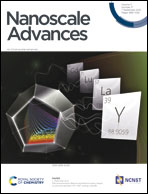A new strategy for improving the electrochemical performance of perovskite cathodes: pre-calcining the perovskite oxide precursor in a nitrogen atmosphere†
Abstract
Increasing the concentration of oxygen deficiency in perovskite oxides by suitable cation doping or anion doping can significantly increase the cathode ionic conductivity, thus improving the oxygen reduction reaction activity in solid oxide fuel cells (SOFCs). Herein, pre-calcining the perovskite oxide precursor in N2 atmosphere is a new strategy to further improve the oxygen non-stoichiometry (δ) and electrocatalytic activity of the cathode. The obtained nitrogen-treated Sm0.5Sr0.5CoO3−δ (SSC) powder has higher oxygen non-stoichiometry than the untreated one. The δ value is 0.27 for SSC-400 at 800 °C in air. The obtained nitrogen-treated SSC-400 cathodes calcined at 1000 °C show improved electrochemical performance compared to SSC–air, achieving the polarization resistance (Rp) values to be 0.035, 0.078 and 0.214 Ω cm2 at 700 °C, 650 °C and 600 °C. The maximum power density of the cell with the SSC-600 cathode reaches 0.87, 1.16 and 1.24 W cm−2 at 600, 650 and 700 °C, which are more excellent than SSC–air. Pre-calcining the perovskite oxide precursor in N2 at a suitable temperature can remarkably improve the electrochemical capability of the cathode and provide a convenient and useful strategy to alleviate the problem of oxygen deficiency in perovskite oxides.



 Please wait while we load your content...
Please wait while we load your content...